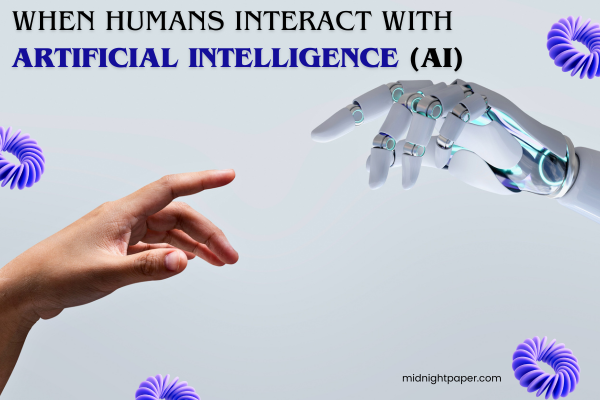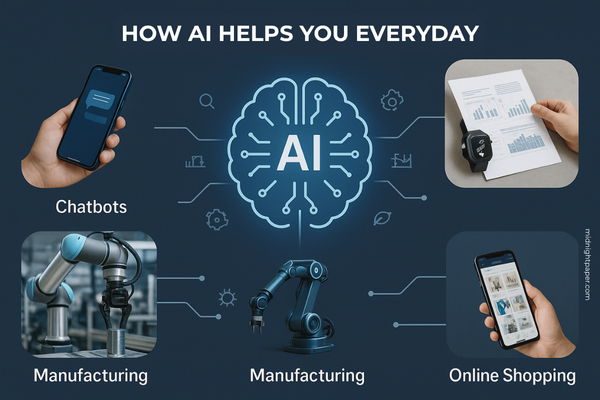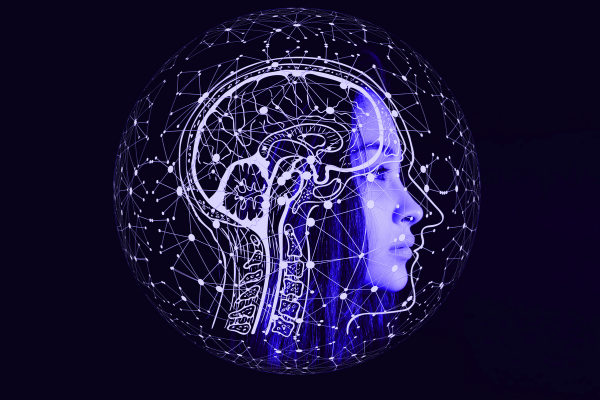Artificial intelligence (AI) is the imitation of human intelligence by machines. Have you ever asked Siri or Google Gemini a question or wondered how a car operates without a driver?
All of this is possible in this modern era. The secret behind all this smart technology is Artificial Intelligence (AI).
What Is ARTIFICIAL INTELLIGENCE (AI) ?
When a machine or computer can think like a human, learn something, type something on its own, or make decisions, we call it Artificial Intelligence (AI).
It helps various software and machines solve problems, recognize images, create images, understand language, and even generate short comments. All this happens without the help of any human.
In simple terms, it gives these machines a brain.
Evolution of AI from 1950 to Now :

- 1950: British mathematician Alan Turing first asked the question in his famous Computing Machinery and Intelligence: “Can machines think?” This is where the concept of Artificial Intelligence originated.
- 1956: The term “Artificial Intelligence (AI)” was coined by John McCarthy at a conference at Dartmouth College. AI initially focused on some symbolic problem solving and some logic-based systems. Progress in Artificial Intelligence at that time was slow, and this effort largely ground to a halt in the 1970s to early 80s.
- 1980 – 2000: During this period, some further developments on AI led to a slight increase in the computing power of AI. And since then, Artificial Intelligence has not had to look back because it started to develop continuously from this period.
- 2010 – NOW: A major breakthrough came in the world of AI in 2012, when deep learning models achieved unprecedented results in various types of image recognition. This was the beginning of modern Artificial Intelligence (AI).
Today, AI powers everything from voice making to self-driving cars, medical diagnostics, and language translation. Through the development of language models and generative AI like OpenAI’s GPT series, AI is now shaping society in a new way with cutting-edge capabilities.
How does AI work?
Artificial intelligence (AI) helps machines “learn” from data and make decisions just like humans, but the difference is that it can do so much faster than humans.
Imagine teaching a child to recognize balls. You show them many pictures of balls and explain the shape until they can identify that this object is a ball. AI learns in the same way. We provide a computer with numerous examples (called data), and AI learns to identify patterns from them.
AI uses algorithms that help machines learn from data by following step-by-step instructions. Once trained, AI can efficiently perform the following tasks:
- Understand and respond to text or speech (e.g. Siri or Alexa)
- Predict outcomes (e.g. weather app or stock forecast)
- Recognize images (e.g. tagging people in images).
- AI can also create new things (e.g. generated art or text or voice).
The more data AI is shown, the better its decision-making abilities will be. Some AI systems follow strict instructions, while others use machine learning, which means they improve themselves by learning from experience, just like humans improve themselves over time.
In short: AI works by learning from data, finding patterns, and making decisions—like a super-fast, data-smart brain.

What uses does AI have in our daily lives?
Artificial Intelligence (AI) has made our lives a lot easier. From the health sector to manufacturing, from driving to product analysis, from traveling to digital marketing, everything has taken on a new dimension thanks to AI.
Healthcare:
- PathAI: Helps pathologists diagnose diseases accurately through AI-powered pathology analysis.
- IBM Watson Health: Helps doctors diagnose diseases like cancer by analyzing vast amounts of medical data.
- AI in medical imaging: Detects broken bones, abnormalities, X-rays, MRIs, and CT scans.
Smartphone Use :
- Voice Assistant (Siri, Google Assistant, Alexa): When we give voice commands, it uses Natural Language Processing (NLP) to understand and respond to those commands
- Camera AI: Improves image quality by detecting scenes, faces, and objects in images.
- Auto-correction and predictive text: Artificial intelligence (AI) learns your typing style, suggests words as you type, and corrects spelling errors.
Automotive :
- Driver Monitoring System: Artificial Intelligence is so powerful that if a driver gets distracted or falls asleep while driving, AI is able to take control of the moving car with its sophisticated technology. However, this feature is not available in all vehicles; it is typically found in more expensive models, such as Tesla cars.
E-Commerce:
- Online Product Recommendation: AI suggests products based on your internet browsing and your previous purchase history from an e-commerce site.
- Dynamic Pricing: Adjusts product prices based on demand and user behavior.
- Chatbots: AI handles customer queries through online chat and provides 24/7 customer support.
Social Media:
- Facebook and Instagram Feed: Artificial Intelligence or AI personalizes your feed based on your past interactions on social media platforms.
- Deepfake Technology: Currently, AI technology is so advanced that AI creates synthetic videos that mimic real people (It is used in both positive and negative ways).
Digital Marketing:
- Content Creation and Optimization: Artificial Intelligence (AI) also automatically creates and optimizes a variety of ads, emails, and social media posts.
- AI-Optimized Landing Pages: AI helps design high-converting Landing Pages that are tailored to user behavior, significantly enhancing marketing performance.
Finance:
- Fraud Detection (e.g., Mastercard, PayPal): Detects various unusual transactions to prevent fraud.
- Robo-Advisors (e.g., Wealthfront, Betterment): Artificial Intelligence helps users manage investments with minimal human input.
Industry & Manufacturing:
- Predictive Maintenance: AI uses its cutting-edge technology to predict when machines will fail so they can be fixed in advance.
- Assesses product quality or detects defects in products during production through computer vision.
- Work with Robots in Factories: AI-powered robots perform a variety of tasks alongside humans in factories, from manufacturing to packaging.
Airports and Travel:
- Facial recognition at airports (e.g., Delta Heathrow) improves boarding and security processes through AI technology.
- AI-powered travel apps (Google Traveler, Hopper, Kayak) predict flight and hotel room prices to recommend the best times to book.
Why is AI important?
From how we work to how doctors treat patients, it’s changing everything.
AI is important because-
- AI speeds up the work process.
- AI can analyze massive amounts of data in seconds.
- Helps businesses grow.
- Artificial Intelligence Automates human tasks.
- AI creates personalized experiences.
Is Artificial Intelligence (AI) Dangerous?
While AI can greatly accelerate the pace of work, there are challenges.
Job Displacement:
AI can automate tasks, posing a risk of unemployment for workers who perform repetitive tasks.
Bias and Policy:
If AI systems are trained on bad data, they can make unfair decisions in policing, hiring, and more.
Loss of Control:
Superintelligent AI, if not properly controlled, can become subject to human control, which is very difficult to stop, which could lead to an existential crisis.
Conclusion: Start your AI journey today.
Artificial Intelligence (AI) is no longer a science fiction. It is deeply embedded in our daily lives.
AI offers many benefits, but its misuse or lack of control can be dangerous. Therefore, responsible development and global oversight are essential for a safe AI future.
Whether you are a teacher, student or businessman, if you can embrace AI positively, it will give you many benefits in the future.


Good content